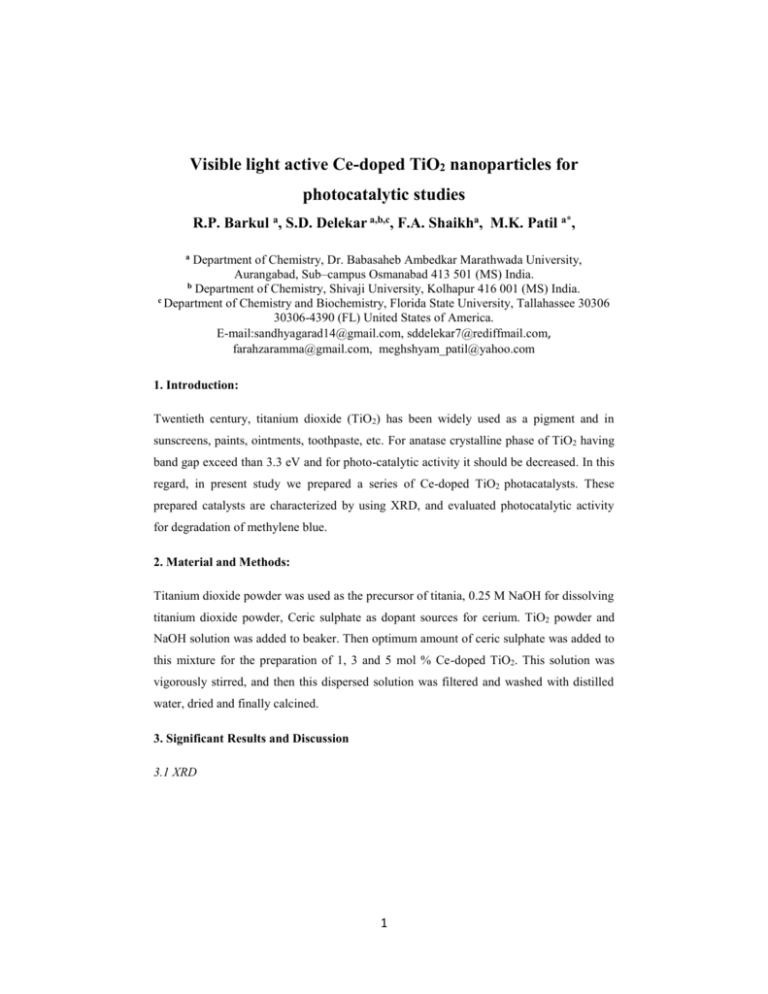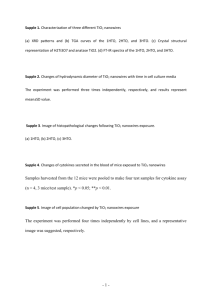150715220259AbstractforsuschemeCeTiO2
advertisement

Visible light active Ce-doped TiO2 nanoparticles for photocatalytic studies R.P. Barkul a, S.D. Delekar a,b,c, F.A. Shaikha, M.K. Patil a*, a Department of Chemistry, Dr. Babasaheb Ambedkar Marathwada University, Aurangabad, Sub–campus Osmanabad 413 501 (MS) India. b Department of Chemistry, Shivaji University, Kolhapur 416 001 (MS) India. c Department of Chemistry and Biochemistry, Florida State University, Tallahassee 30306 30306-4390 (FL) United States of America. E-mail:sandhyagarad14@gmail.com, sddelekar7@rediffmail.com, farahzaramma@gmail.com, meghshyam_patil@yahoo.com 1. Introduction: Twentieth century, titanium dioxide (TiO2) has been widely used as a pigment and in sunscreens, paints, ointments, toothpaste, etc. For anatase crystalline phase of TiO2 having band gap exceed than 3.3 eV and for photo-catalytic activity it should be decreased. In this regard, in present study we prepared a series of Ce-doped TiO2 photacatalysts. These prepared catalysts are characterized by using XRD, and evaluated photocatalytic activity for degradation of methylene blue. 2. Material and Methods: Titanium dioxide powder was used as the precursor of titania, 0.25 M NaOH for dissolving titanium dioxide powder, Ceric sulphate as dopant sources for cerium. TiO2 powder and NaOH solution was added to beaker. Then optimum amount of ceric sulphate was added to this mixture for the preparation of 1, 3 and 5 mol % Ce-doped TiO2. This solution was vigorously stirred, and then this dispersed solution was filtered and washed with distilled water, dried and finally calcined. 3. Significant Results and Discussion 3.1 XRD 1 XRD of Ce-doped TiO2 (1, 3, and 5 mol %), catalysts shows the presence of anatase and rutile phase of TiO2. Particle size found to be between 21 to 23nm (shown in Table 1). Doping increases the size of nanoparticles. Table 1: Particle size of Ce doped TiO2 Sr. No. Catalyst Particle size 1 1 mol % Ce-doped TiO2 21.32 nm 2 3 mol % Ce-doped TiO2 22.48 nm 3 5 mol % Ce-doped TiO2 23.78 nm 3.2 Photocatalytic degradation of Rhodamine B 0.7 0.6 00 min 20 min 1 hour 2 hour 3 hour 4 hour Ce-TiO2 3 mol % Absorbance 0.5 0.4 0.3 0.2 0.1 200 300 400 500 600 700 800 Wavelength(nm) Fig. Photocatalytic degredation of methylene blue with 3 mol % Ce-doped TiO2 catalyst. Methylene blue is a heterocyclic aromatic chemical compound with the molecular formula C16H18N3SCl. It has many uses in a different fields including biology and chemistry The photocatalytic activity of pure and Ce-doped TiO2 samples was established for the 2 degradation of Methylene blue dye under direct sunlight irradiation. The reaction was monitored by taking UV-Visible spectrometer. The effect of doping concentration of catalyst (0-5 mol%) on the photocatalytic degradation was studied. From observations, it is clear that degradation of methylene blue efficiently taken place by Ce-doped TiO2 catalysts. For pure TiO2 catalyst very less degradation is observed. Within prepared Cedoped TiO2 catalysts, the order of degradation activity is: 5 mol% Ce-doped TiO2 > 3 mol% Ce-doped TiO2 > 1 mol% Ce-doped TiO2 Conclusions: In this study we successfully prepared 1 mol%, 3 mol% and 5 mol% Ce-doped TiO2. From XRD prepared catalyst shows both rutile as well as anatase TiO2. These prepared catalyst shows prominent activity for degradation of methylene blue. As from the obtained results pure TiO2 shown less activity for degradation. The order of degradation activity in Cedoped TiO2 catalysts is: 5 mol% Ce-doped TiO2 > 3 mol% Ce-doped TiO2 > 1 mol% Cedoped. References [1] Fujishima, and K. Honda, Nature, 238, 1972, 37–38 [2] Gao Xiao, Xin Huang, Xuepin Liao, and Bi Shi, J. Phys. Chem. C, 117 (19) 2013, 9739–9746 [3] Sungmin Chin, Eunseuk Park, Minsu Kim and Jongsoo Jurng, Powder Technology, 201, 2010, 171-176 3





